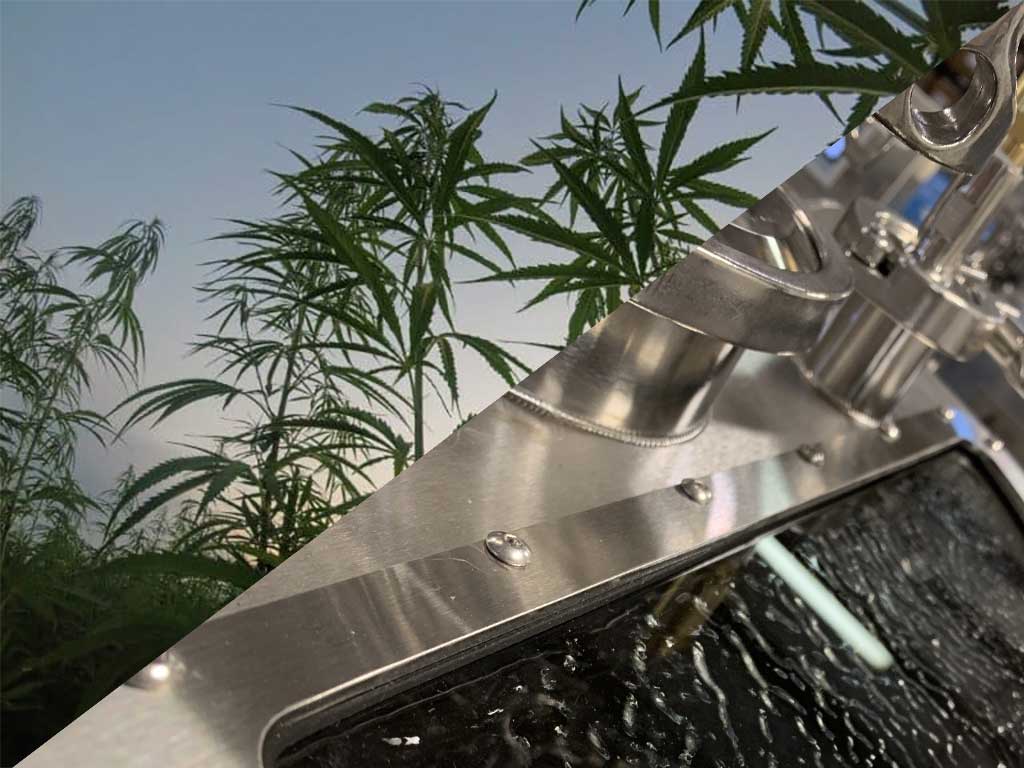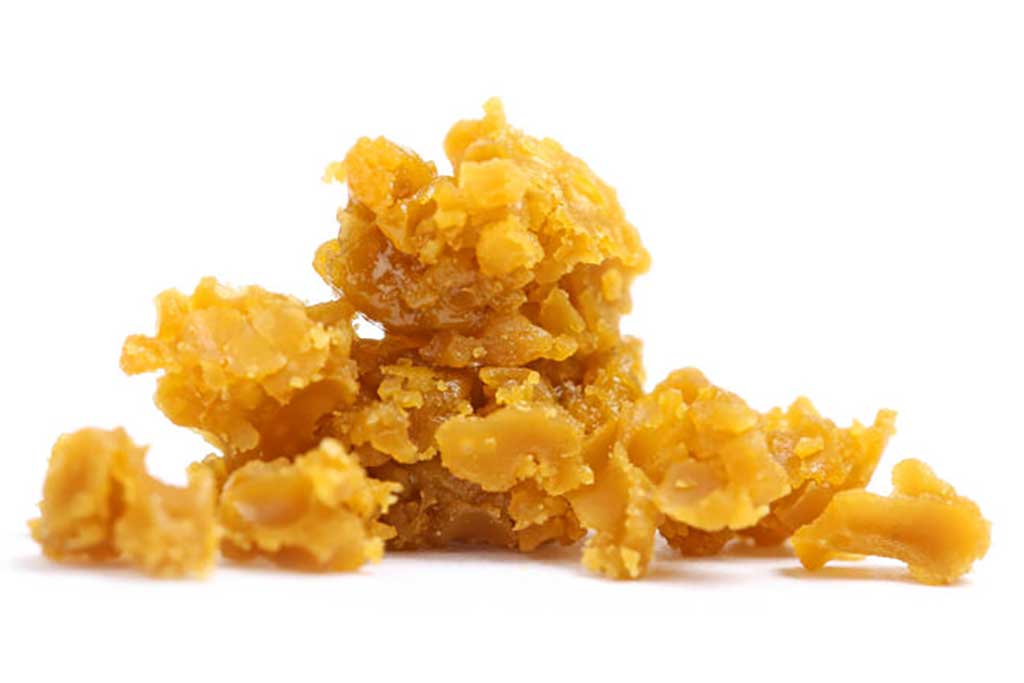Cannabis processing has many variables, including solvent type. Here, we cover the most frequently asked questions about the cannabis extraction process and two of the most common methods used: ethanol, hydrocarbons, and CO2 extraction.
General Cannabis Extraction FAQ
How fine or coarse should you mill your biomass?

How finely mill or shred cannabis or hemp biomass plays a large role in determining how much biomass can fit into the extraction chamber. The mill size of the cannabis plant matter can determine the quality of the resin from cannabis extractions. The right particle size can produce an extract with a desirable level of cannabinoids and terpenes while minimizing the amount of chlorophyll.
The finer you mill your biomass, the more surface area is available and the quicker the solvent will dissolve the cannabinoids, which include:
- Terpenes — are the compounds that give cannabis and hemp products their distinctive aromas and contribute to their varied flavors. Different combinations of terpenes are widely considered to be a driving factor in the type of high that consumers experience.
- Crude oil — the dark, a highly viscous substance similar in texture to thick molasses. Although it is rich in the major (CBD and THC) and minor cannabinoids (CBN and CBG), it still contains undesirable components such as plant particulates, solids, and waxes. Removing these components requires that crude oil be further refined. Crude oil is one of the major building blocks of the cannabis industry because most end-products start off as crude before being further refined and purified.
- Resin — the valuable oily compounds contained in trichomes, including terpenes, flavonoids, and high concentrations of cannabinoids such as THC. Resin can also contain undesirable elements like waxes and chlorophyll. Resin is typically further processed into dabbling concentrates.
To maximize extraction process efficiency, we recommend milling biomass between 40 and 60 mesh. The particle size of cannabis plant material that is too large can reduce the extraction efficiencies of the co2 extraction system because the solvent will not fully penetrate it to achieve a complete extraction. At the same time, you want to avoid a ground feed that is too fine, a powdery consistency can introduce undesirable compounds to your cannabis extract and increase the amount of time and labor needed to remove the contaminants.
Another important consideration related to mill size: there are also compounds within the biomass that operators should avoid extracting. They are usually found within the cells of the plant, but if these walls are shredded, the compounds can break through and release undesirable compounds into the solvent. This also leads to extra filtration and processing time.
One other impact of mill size is on the productivity of your extraction process. More fine-milled biomass can be uniformly packed into the filter bags used in ethanol centrifuge extraction processes or loaded directly into CO2 extraction vessels compared to coarse-milled biomass. So mill size directly influences how many pounds of biomass can be processed during each extraction.
What Extraction Equipment for Cannabis Extraction?
Cannabis operators can work with extraction equipment manufacturers to find processing solutions for their business, depending on the type of chemical or organic solvents used, such as ethanol, hydrocarbons, or supercritical carbon dioxide.
Both hydrocarbon and CO2 extraction use closed-loop extractors, so the system is completely sealed. The solvent is reclaimed and reused.
There are three types of cannabis extraction equipment to be considered.
Ethanol Extraction Equipment
Ethanol extraction can produce several different cannabinoid derivatives, making it a stellar option for small-scale processors creating connoisseur products and for larger labs looking to isolate specific terpenes or cannabinoids like CBD and THC in larger quantities.
CO2 Extraction Equipment
CO2 as a gas solvent is volatile and leaves no trace residue. This is critical for THC and CBD medicinal products, which may be used by people with compromised immune systems.
CO2 is also an excellent option for extracting fragile plant terpenes for high-quality distillates that maintain the flavor profiles of the original plant.
Hydrocarbon Extraction Equipment

Hydrocarbon extraction equipment is typically less expensive than CO2 and ethanol extraction equipment. The use of hydrocarbons (propane, butane, or hexene) helps maintain each strain’s authentic flavors, which are made up of a combination of cannabis flavonoids, terpenes, and cannabinoids.
A skilled laboratory technician can attain up to a 90% concentration of cannabinoids with very high purity and adjust butane and propane to produce a range of specific salable products.
Other
In addition to the three types of cannabis extraction systems, cannabis processors may require a walk-in freezer, an inline color remediation column, a vacuum pump, an oven, and a rotary evaporator to efficiently extract cannabinoids and terpenes and remove impurities.
Cannabis Ethanol Extraction FAQ
What is cannabis Extraction Process of Ethanol Extraction?
Ethanol extraction technicians begin by applying the ethanol solvent to the biomass to strip the desired compounds. Then, processors can remove undesirable compounds through winterization and filtration to remove residual solvent from the final extract product.
Ethanol extraction involves introducing a solvent to separate the oils from plants; Has two ways to extract cannabis with ethanol: Cold and warm ethanol extraction.
Cold ethanol extraction
In the cold ethanol extraction process, the ethanol and plant material, while separated, are brought to freezing temperatures, using commercial freezers, medical freezers, or dry ice. The two are then combined and mixed, which allows the cold ethanol to strip oils and other desirables from the plant material. The plant material is then strained, and the wash from this is filtered further. Once this filtering is completed, the ethanol is removed from the resulting concentrate, using low-temperature heat and vacuum for evaporation. This process allows up to 98% ethanol recovery, leading to very little waste. This method is highly efficient, can increase extraction yields, reduces the need for the winterization step, and is highly safe for both small and extremely large industrial-scale operations.
Warm ethanol extraction
Warm or hot ethanol extraction typically requires special equipment. One popular method is the Soxhlet technique. The raw plant material is placed in a special piece of equipment called a Soxhlet extractor. Warm ethanol is passed over the material multiple times, and the solvent is recycled, is far easier to perform, yet undesirable compounds – such as water, fats, and lipids – are significantly more difficult to remove and are typically pulled out in the ethanol. That means they will either need to be removed later, through a further winterization step, or they will be in the final product.
Warm ethanol extracted oil should be winterized by chilling the ethanol and oil mixture for a higher-quality end product. This freezes the undesirable materials so that they can be easily filtered out from the mixture.
3 Tips for Ethanol Extraction for Cannabis
- While cold ethanol extraction is highly-effective and removes undesirable compounds in one stream, the same winterization filtration process can be performed with the cold ethanol extraction method to improve the quality of the product even further.
- Whether manufacturers decide to use the cold or warm ethanol extraction method, approximately 0.5 to 1 gallon of ethanol is used per pound of biomass. Agitating the biomass and ethanol, whether done manually or mechanically, assists further with increasing yields.
- To recover the solvent, the crude extract is placed under a vacuum (heat can be applied). The vacuum environment reduces the solvent’s boiling point to evaporate and recycle it for later use easily, making it a highly-cost effective solvent for your business.
What Are the Pros and Cons of Ethanol Extraction?
Pros Of Ethanol Extraction
Ethanol extraction is one of the most popular methods of extracting cannabidiol (CBD) from hemp plants. It’s easier to store Ethanol in large quantities for industrial use due to the leniency in the storage requirements. This processing method has a high throughput compared to BHO or supercritical fluid extraction (CO2) extractions and is best used for producing hemp isolates and distillates in large volumes.
Cons Of Ethanol Extraction
Ethanol is polar, making it more unspecific. Thus, it can extract more water-soluble plant components, including waxes, fats, and chlorophyll. Ethanol extraction can remove valuable terpenes from the biomass, reducing the flavor and aroma of the final extract product. It has a higher boiling point than hydrocarbons. Thus, the recovery process is much slower and more difficult with this extraction method. The extraction method has lower purity levels than hydrocarbon extraction methods. Thus, it’s difficult to achieve the more pure crystalline cannabis concentrate. Ethanol post-processing is expensive, labor intensive, and involves several processing steps. Ethanol is also flammable and requires a C1D2 control room.
What Is the Best Ethanol for Cannabis Extraction?
Avoid using denatured alcohol since it contains additional chemicals inside that may not be safe for human consumption.
Ethanol is a colorless, volatile, and flammable liquid (C2H5OH), it can be made from fermenting corn, wheat, potatoes, and other starches. There are different types of ethanol available for purchase that can be used during the extraction process.
200 proof USP grade ethanol, 190 proof USP grade ethanol
The water content in the solution determines the strength or purity of the ethanol. Ethanol that is 200 proof is composed of 100% ethanol, while 190 proof ethanol is composed of 5% water and 95% ethanol. Companies can choose to reproof their ethanol using distillation equipment to lengthen the usage period.
This can be a cost-effective method, as buying pure ethanol can be expensive. Ethanol used in the extraction processes is usually USP grade. This stands for United States Pharmacopeia and means the product is acceptable for food, drug, or medicinal use.
Cannabis BHO Extraction FAQ
What Is the Process of BHO Extraction?
In BHO Extraction, technicians may use dewaxing and color remediation processes to purify the extract. Processors may use a blend of propane and butane to extract more terpenes.
BHO extraction involves applying a high-purity butane over the loaded biomass in the material tank. In the closed-loop extraction process, the plant material is packed into the material column. The butane is chilled to cold temperatures in a solvent column and pumped over a packed material column. The solvent separates the cannabinoids and terpenes from the plant to produce BHO crude oil.
In the collection tank, after the primary extraction, the solvent and BHO extracts are heated in order for the butane to evaporate. A gas compressor pulls out the evaporated butane from the recovery column. The solvent goes through the condensing column, which cools the butane gas into a liquid form again.
What Are the Pros and Cons of BHO Extraction?
Pros
- Greater terpene expression, truer to the strain – BHO is great at terpene preservation. Though there are no studies conducted to confirm this, it is believed that BHO will preserve more terpenes as compared to CO2 extraction;
- Wide variety of products available, with differing tastes and effects – BHO produces highly concentrated extracts;
- Often considered a stronger product – the cannabinoid content can be as high as 70%-90% depending on how the extraction is carried out;
- Full-spectrum extract – Full-spectrum extracts containing all of the plant’s valuable compounds, not just THC and a small portion of the original terpenes. Full-spectrum harnesses the therapeutic power of cannabinoids and terpenes to create an elevated experience with greater benefits and fewer side effects.
Cons
Closed-loop butane and propane extraction methods are two most was the popular of the safest and most efficient extraction processes available: they can help produce a wide range of concentrates such as shatter, live resin, and diamonds, and they can also preserve more of the plant’s aromatic terpenes.There are several advantages that led in part to its past popularity, one of them being that it is a relatively cheap method. It is also time-saving.
However, BHO systems are known to provide a lower throughput than ethanol, which can be a sacrifice for higher quality cannabis oil. In addition, fire restrictions and lower storage limits are required for BHO compared to ethanol.
At the end of the day, BHO is a less safe method as compared to carbon dioxide extraction, all factors considered.
The other concern with BHO has been the amount of residue that remains in the final product. It is difficult to get rid of all the butane even with a vacuum purge. This is a health hazard since butane is extremely unsafe when ingested. That makes it essential to test cannabis products for any residual solvents before they are made available to consumers, regardless of the extraction method used.
Cannabis CO2 Extraction FAQ
What Is the Process of CO2 Extraction?
A closed-loop co2 extraction system uses the naturally-occurring C02, which is odorless, colorless, and capable of dissolving cannabis resin from the plant.
When carbon dioxide is used during cannabis extraction it can be either used in a supercritical or subcritical state. In this CO2 extraction method, carbon dioxide is compressed at extremely high pressures, where it turns into a liquid-gaseous phase. When blasted through the cannabis plant material, it strips away the trichomes and extracts the cannabinoids. After this, the carbon dioxide is easily evaporated from the extract to leave behind an almost pure extract.
Because of the very high pressure of the supercritical CO2 fluid, and this pressure strips the plant clean, so during the supercritical CO2 extraction process, many of the flavorful terpenes are removed from the cannabis resin. But the subcritical CO2 extraction is at a lower pressure and temperature than average CO2 extraction methods. This enables more terpenes to be preserved and then reintroduced those terpenes into the final products. Supercritical carbon dioxide is commonly used on a commercial scale because it is highly effective at extracting cannabinoids.
What Are the Pros and Cons of CO2 Extraction?
Pros
CO2 extraction utilizes an inert gas for processing instead of a liquid solvent or explosive gas. CO2 extractions are thought to provide the lowest risk of residual solvent, which means that consumers are less likely to inhale unnecessary pollutants like butane.CO2 enables the capture of terpenes prior to extraction for later use. CO2 systems operate at high pressures and varying temperatures, but without volatile compounds so no control zone is required for safety.
Cons
CO2 extraction has a lower throughput than ethanol. CO2 raw extract requires additional processing to remove lipids, fats, and waxes. More expensive. Often considered a weaker product.
Works Cited
- “5 Questions Every Cannabis Extractor Should Be Able to Answer”, Analytical Cannabis, 09 Aug. 2022, https://www.analyticalcannabis.com/articles/5-questions-every-cannabis-extractor-should-be-able-to-answer-313467
- “Cannabis Extraction Equipment 101”, Precision Extraction Solutions, , 09 Aug. 2022, https://precisionextraction.com/2021/11/cannabis-extraction-equipment-101/
- “How Does Ethanol Extraction Work?”, ExtractCraft LLC, 09 Aug. 2022, https://www.extractcraft.com/how-does-ethanol-extraction-work-for-botanical-extraction/
- “Cannabis and Hemp Extraction Methods: What is Ethanol Extraction?”, Maratek, 09 Aug. 2022, https://www.maratek.com/cannabis-oil-extraction-and-recovery-blog/cannabis-and-hemp-extraction-methods-what-is-ethanol-extraction
- “Pros & Cons Of Ethanol Extraction”, FASHION-MOMMY, 09 Aug. 2022, https://www.fashion-mommy.com/pros-cons-of-ethanol-extraction/
- “How to Purchase Ethanol for Cannabis or Hemp Oil Extraction?”, Maratek, 09 Aug. 2022, https://www.maratek.com/cannabis-oil-extraction-and-recovery-blog/how-to-purchase-ethanol-for-cannabis-or-hemp-oil-extraction
- “BHO TOOLS 101: PROFESSIONAL TOOLS FOR BHO EXTRACTION”, Media Bros, 09 Aug. 2022, https://mediabros.store/blogs/news/bho-tools-101-professional-tools-for-bho-extraction
